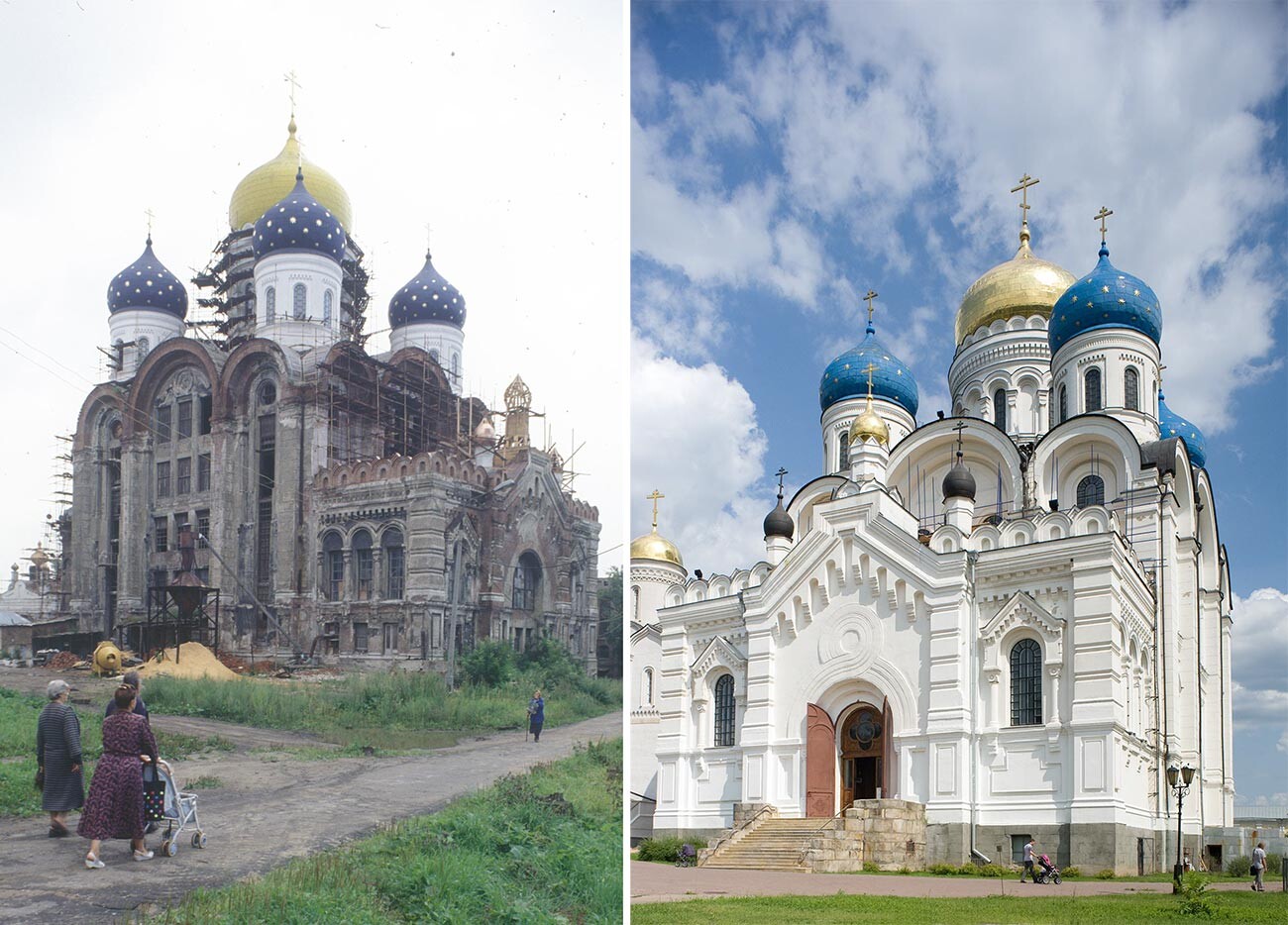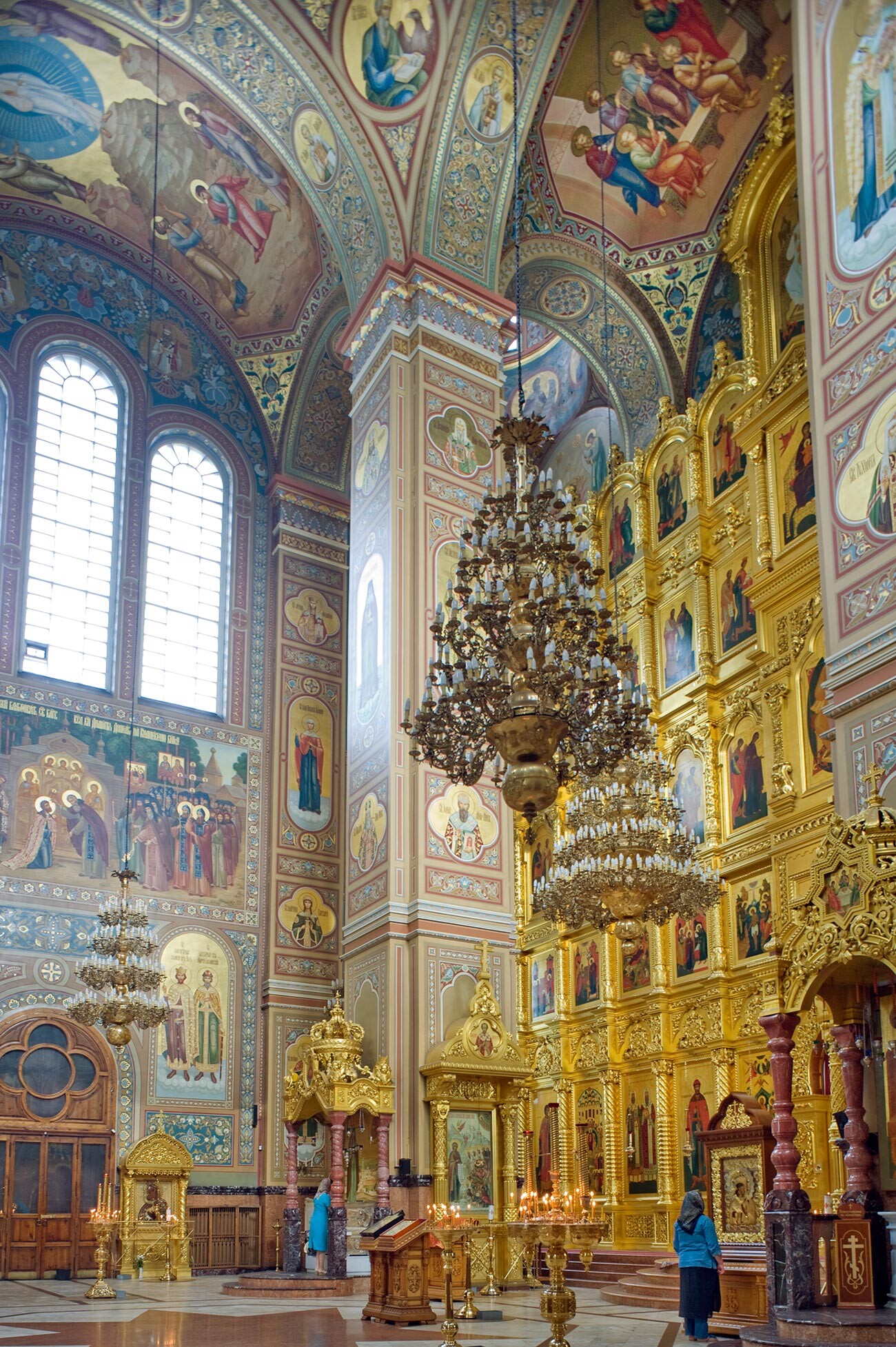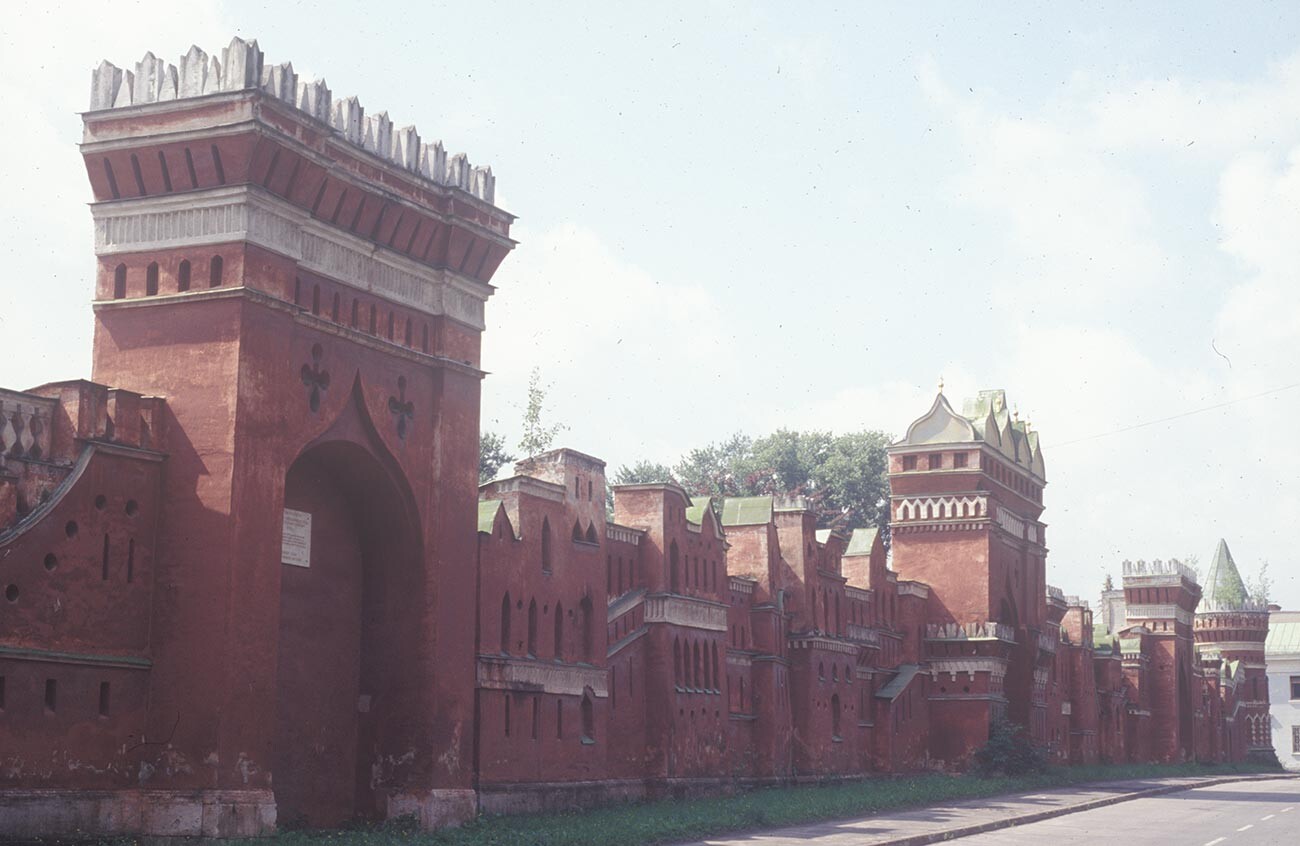A tale of two monasteries: submersion and revival

 Dzerzhinsky (near Moscow). St. Nicholas-Ugreshky Monastery, Cathedral of St. Nicholas (foreground) & Transfiguration Cathedral. Northwest view with New Cloisters in background. July 10, 2013
Dzerzhinsky (near Moscow). St. Nicholas-Ugreshky Monastery, Cathedral of St. Nicholas (foreground) & Transfiguration Cathedral. Northwest view with New Cloisters in background. July 10, 2013
At the beginning of the 20th century, Russian chemist and photographer Sergey Prokudin-Gorsky developed a complex process for vivid, detailed color photography. Inspired to use this new method to record the diversity of the Russian Empire, he photographed historic sites over a vast geographical range during the decade leading up to World War I.
 Leushino. Convent of Nativity of John the Baptist (now submerged in Rybinsk Reservoir). Bell tower & Church of St. John of Ryla over Holy Gate. Summer 1909
Leushino. Convent of Nativity of John the Baptist (now submerged in Rybinsk Reservoir). Bell tower & Church of St. John of Ryla over Holy Gate. Summer 1909
Logistical support for his journeys came from the Ministry of Transportation, which commissioned him to photograph in June and July 1909 along the Mariinsky Waterway in northwestern Russia. This water route was intrinsically connected with the development of St. Petersburg, founded in 1703, and designated the capital of Russia in 1712.
The Mariinsky Waterway system extended from the Neva River at St. Petersburg to Lake Ladoga, then via the Svir River to the southern shore of Lake Onega. Beyond Onega, the Vytegra River and canal led via the Kovzha River to White Lake (‘Beloe Ozero’). That lake is drained by the Sheksna River, which, on its way to the Volga port of Rybnisk, flows past what is now the industrial behemoth of Cherepovets.
Convent of the Nativity of John the Baptist
 St. Nicholas-Ugreshky Monastery. Cathedral of St. Nicholas, west view. July 10, 2013
St. Nicholas-Ugreshky Monastery. Cathedral of St. Nicholas, west view. July 10, 2013
During his journey along the Sheksna in 1909, Prokudin-Gorsky took a striking series of photographs documenting the Convent of the Nativity of John the Baptist at Leushino, 35 km south of Cherepovets. Although founded as a monastic community only in 1875, the convent and its icon painting workshop had become among the most renowned in Russia by the time of the photographer’s visit. There, he photographed an expansive complex of brick buildings, including the imposing ‘Praise to the Holy Virgin’ Cathedral, all erected with the active supervision of Abbess Taisy (Solopova; 1842-1915).
Although the convent continued to function until 1931, its location near the Sheksna proved fatal. With the creation of the vast Rybinsk Reservoir - a major link in the Soviet Volga-Balt Canal - most of the convent’s buildings were either dismantled for brick or succumbed to the water’s rise over a period from 1941 to 1947. The few towering remains were destroyed in the 1950s by the battering force of annual spring ice floes.
 St. Nicholas-Ugreshky Monastery. Transfiguration Cathedral, east view (under restoration). August 4, 1996
St. Nicholas-Ugreshky Monastery. Transfiguration Cathedral, east view (under restoration). August 4, 1996
Prokudin-Gorsky’s photographs are now a priceless record of the achievements of Abbess Taisy and her community at the turn of the 20th century. During the same period, another monastic institution underwent an ambitious construction surge in the latter 19th century, only to face a similarly perilous future.
St. Nicholas-Ugreshsky Monastery
 Left: St. Nicholas-Ugreshky Monastery. Transfiguration Cathedral, northwest view (under restoration). August 4, 1996.
Right: Transfiguration Cathedral, west view. July 10, 2013
Left: St. Nicholas-Ugreshky Monastery. Transfiguration Cathedral, northwest view (under restoration). August 4, 1996.
Right: Transfiguration Cathedral, west view. July 10, 2013
Of the many monasteries and convents in the Moscow area, few have a more distinctive history than the St. Nicholas-Ugreshsky Monastery, located in what is now the town of Dzerzhinsky, just to the south of Moscow. Indeed, the monastery was founded in 1380 by Moscow’s Grand Prince Dmitry Donskoy, a seminal figure in the development of Muscovy.
 St. Nicholas-Ugreshky Monastery. Transfiguration Cathedral, restored interior. View northeast toward new icon screen. July 10, 2013
St. Nicholas-Ugreshky Monastery. Transfiguration Cathedral, restored interior. View northeast toward new icon screen. July 10, 2013
According to legend, the famous prince and military leader saw an icon of St. Nicholas that miraculously appeared in a tree near a meadow where he and his troops had stopped to rest. The army was on its way south in the late Summer of 1380 to confront a large Tatar army in an epochal battle that would become a defining point in Russian history - the victory over Khan Mamai at Snipe Field (‘Kulikovo Pole’) near the Don River.
 St. Nicholas-Ugreshky Monastery. Transfiguration Cathedral, restored interior. Ceiling vaults & main dome. July 10, 2013
St. Nicholas-Ugreshky Monastery. Transfiguration Cathedral, restored interior. Ceiling vaults & main dome. July 10, 2013
Interpreting the appearance of the icon as a good omen, Prince Dmitry ordered the establishment of a monastery at the site. According to a medieval narrative, the miraculous icon warmed (“ugreshe”) the heart of Prince Dmitry, thus giving rise to the popular designation of the monastery, which is formally dedicated to St. Nicholas.
 Left: St. Nicholas-Ugreshky Monastery. Church of the Dormition. Southwest view with original 18th-century bell tower containing Church of Decapitation of John the Baptist. August 4, 1996
Right: Church & bell tower with two 19th-century tiers restored after demolition in Soviet period. July 10, 2013
Left: St. Nicholas-Ugreshky Monastery. Church of the Dormition. Southwest view with original 18th-century bell tower containing Church of Decapitation of John the Baptist. August 4, 1996
Right: Church & bell tower with two 19th-century tiers restored after demolition in Soviet period. July 10, 2013
Situated near the court village of Ostrov, the attractive location just to the north of the Moscow River was already well known to Moscow’s princely elite and the new monastery rapidly rose in status. By the 15th century, it had its own legation in the Kremlin.
From wood to masonry
 St. Nicholas-Ugreshky Monastery. From left: bell tower with attached infirmary, Church of Icon of the Virgin "Comfort to all who Grieve," east cloisters. South view. August 4, 1996
St. Nicholas-Ugreshky Monastery. From left: bell tower with attached infirmary, Church of Icon of the Virgin "Comfort to all who Grieve," east cloisters. South view. August 4, 1996
Like other Moscow monasteries, St. Nicholas-Ugreshsky shared the city’s turbulent fate. Built of wood in its early centuries, the monastery was burned to the ground in 1521 during a major attack on Muscovy by Crimean Tatar khan Mehmed I Giray (1465-1523).
 St. Nicholas-Ugreshky Monastery. From left: bell tower, Chapel of
Appearance of Icon of St. Nicholas, infirmary, Church of Icon of the Virgin "Comfort to all who Grieve," east cloisters. Southwest view. July 10, 2013
St. Nicholas-Ugreshky Monastery. From left: bell tower, Chapel of
Appearance of Icon of St. Nicholas, infirmary, Church of Icon of the Virgin "Comfort to all who Grieve," east cloisters. Southwest view. July 10, 2013
Reconstructed shortly thereafter, the monastery gained its first masonry church with the building of the new Cathedral of St. Nicholas, presumably in the 1520s or 1530s. Frequently renovated, parts of the structure were rebuilt in the 1840s. In 1940, the cathedral was razed. As part of the revival of the monastery after 1990, the cathedral was rebuilt in a stylized form suggestive of 15th-century Muscovite architecture.
 St. Nicholas-Ugreshky Monastery. From left: original west tower, Abbot's Chambers, Church of the Dormition (attached to bell tower). Southwest view. July 10, 2013
St. Nicholas-Ugreshky Monastery. From left: original west tower, Abbot's Chambers, Church of the Dormition (attached to bell tower). Southwest view. July 10, 2013
In the latter part of the 16th century the monastery benefited from the largess of Ivan the Terrible. In the early 17th century during the dynastic interregnum and political chaos known as the Time of Troubles, the monastery was occupied by various factions, but by 1611 it had become one of the rallying points for forces in support of Orthodox Russia.
 St. Nicholas-Ugreshky Monastery. Holy Gate with Chapel of St. Nicholas. Right: Prosphora Bakery. July 10, 2013
St. Nicholas-Ugreshky Monastery. Holy Gate with Chapel of St. Nicholas. Right: Prosphora Bakery. July 10, 2013
Throughout the 17th century the St. Nicholas-Ugreshsky Monastery was a pilgrimage site for Tsars Mikhail Romanov and Alexey Mikhailovich, together with their royal suites. The young tsar Peter I, son of Alexey, was a frequent visitor in the late 1680s. Indeed, the monastery gained grim renown in 1698 as a place of detention and interrogation for musketeers (streltsy) involved in the infamous Streltsy revolt against Peter’s authority.
Tertiary purposes
 Left: St. Nicholas-Ugreshky Monastery. Chapel of Appearance of Icon of St. Nicholas (under restoration), southeast view. August 4, 1996.
Right: Chapel of Appearance of Icon of St. Nicholas, southeast view. July 10, 2013
Left: St. Nicholas-Ugreshky Monastery. Chapel of Appearance of Icon of St. Nicholas (under restoration), southeast view. August 4, 1996.
Right: Chapel of Appearance of Icon of St. Nicholas, southeast view. July 10, 2013
With the secularization of Russian society and politics in the 18th century, the influence of monasteries waned, as did financial support. Buffeted by these general trends, the St. Nicholas-Ugreshsky Monastery had specific problems in administrative and spiritual life. With inadequate resources, the monastery was increasingly used to hold social outcasts, indigents and the sick. In 1771 it was quarantined to hold victims of the plague that devastated Moscow.
During this grim period a few steps were taken to maintain the monastery. The St. Nicholas Cathedral was repaired, and in 1758 construction began on a large bell tower, completed in its original form of three levels around 1778. In the fall of 1812, the monastery was briefly occupied and sacked by French troops. By the early 1830s the institution had reached its nadir, and the possibility of closure was considered.
 St. Nicholas-Ugreshky Monastery, skete (monastic retreat). East view across Monastery Pond. August 4, 1996
St. Nicholas-Ugreshky Monastery, skete (monastic retreat). East view across Monastery Pond. August 4, 1996
At this point, the plight of the St. Nicholas-Ugreshsky Monastery came to the attention of two of Russia’s most prominent prelates, Archimandrite Ignaty Brianchaninov and Metropolitan Philaret (Drozdov). Through their intervention and with the generous support of a merchant dynasty led by Peter Alexandrov, the monastery experienced a vigorous revival, symbolized by the renovation of the St. Nicholas Cathedral in the early 1840s.
 St. Nicholas-Ugreshky Monastery. North wall & towers, interior view. August 4, 1996
St. Nicholas-Ugreshky Monastery. North wall & towers, interior view. August 4, 1996
Of special importance to this resurgence was the energetic guidance of Archimandite Pimen Ugreshsky (Petr Myasnikov; 1810-80), who took monastic vows in 1838 and was entrusted with leadership of the monastery by Metropolitan Philaret in 1852. During the latter half of the 19th century, the greatly enlarged monastic territory was redesigned to a concept inspired by Fyodor Solntsev, an artist and archeologist who had a substantial impact on the reinterpretation of Russia’s architectural heritage.
Architectural elements
 St. Nicholas-Ugreshky Monastery. "Palestine Wall" with Central & Gate Towers. Northeast view. August 4, 1996
St. Nicholas-Ugreshky Monastery. "Palestine Wall" with Central & Gate Towers. Northeast view. August 4, 1996
As is often the case with Russian monasteries, the most visible element of the new ensemble was its bell tower. With a firm base provided by the original 18th-century structure, the tower gained four additional levels in 1859 that brought its height to over 90 meters. During the Soviet period the upper tiers were demolished, but the tower has now been restored to its previous height.
The 19th-century building campaign culminated with the construction of the grandiose Cathedral of the Transfiguration, begun in 1880 and completed in 1894. Designed in what is known as the “pseudo-Russian” style by the architects Alexander Kaminsky and Boris Freidenberg, the Transfiguration Cathedral remains one of the largest churches in the Moscow region. The icons in the new icon screen were painted by masters from the traditional artistic center of Palekh.
 "Palestine Wall," Central Tower, whitewashed after restoration. July 10, 2013
"Palestine Wall," Central Tower, whitewashed after restoration. July 10, 2013
The most unusual element of Solntsev’s architectural vision for St. Nicholas-Ugreshsky Monastery occurred with the rebuilding in 1866 of the north wall, which faced the main road to the monastery. Known as the Palestine (or Jerusalem) Wall, this idiosyncratic structure, with its panoply of towers and intersecting visual lines, was meant to suggest the image of the Holy City of Jerusalem as represented in traditional Russian iconography, particularly in the background Crucifixion scenes.
Soviet period & beyond
 "Palestine Wall" with northeast corner tower (17th century). July 10, 2013
"Palestine Wall" with northeast corner tower (17th century). July 10, 2013
Following the establishment of Soviet power, the monastery briefly existed as a commune and was closed in 1925. Monastery buildings were converted to use as a colony for abandoned children (bezprizorniki) during the cataclysmic upheaval of the civil war years. The project was of special interest to Felix Dzerzhinsky, head of the Soviet political police, and after his death in 1926, the newly formed town was given his name.
 "Palestine Wall," view toward Gate Tower. July 10, 2013
"Palestine Wall," view toward Gate Tower. July 10, 2013
Returned to the Orthodox Church in 1991, St. Nicholas-Ugreshsky Monastery began a prolonged process of revival that has led to its current vibrant state. Its educational mission has expanded to include an Orthodox seminary, formed in 2000. Numerous churches and chapels have been restored or entirely rebuilt, with much of the ensemble grouped around a picturesque pond. With its landscaped setting, the monastery provides an oasis to visitors.
And in another twist of fate, in 2015-16 the Leushino-John the Baptist Convent was revived on a much smaller scale at the village of Miaksa, on the left bank of the Sheksna a few kilometers from the site of the original convent. Prokudin-Gorsky’s photographs undoubtedly played an important role in preserving the memory of this shrine, whose foundations lie beneath the waters.
 Left: St. Nicholas-Ugreshky Monastery. Chapel of the Passion of Christ, south view. July 10, 2013.
Rigth: Statue of St. Sergius of Radonezh, with bell tower in background. July 10, 2013
Left: St. Nicholas-Ugreshky Monastery. Chapel of the Passion of Christ, south view. July 10, 2013.
Rigth: Statue of St. Sergius of Radonezh, with bell tower in background. July 10, 2013
In the early 20th century, Russian photographer Sergey Prokudin-Gorsky developed a complex process for color photography. Between 1903 and 1916 he traveled through the Russian Empire and took over 2,000 photographs with the process, which involved three exposures on a glass plate. In August 1918, he left Russia and ultimately resettled in France where he was reunited with a large part of his collection of glass negatives, as well as 13 albums of contact prints. After his death in Paris in 1944, his heirs sold the collection to the Library of Congress. In the early 21st century the Library digitized the Prokudin-Gorsky Collection and made it freely available to the global public. A few Russian websites now have versions of the collection. In 1986 the architectural historian and photographer William Brumfield organized the first exhibit of Prokudin-Gorsky photographs at the Library of Congress. Over a period of work in Russia beginning in 1970, Brumfield has photographed most of the sites visited by Prokudin-Gorsky. This series of articles juxtaposes Prokudin-Gorsky’s views of architectural monuments with photographs taken by Brumfield decades later.

